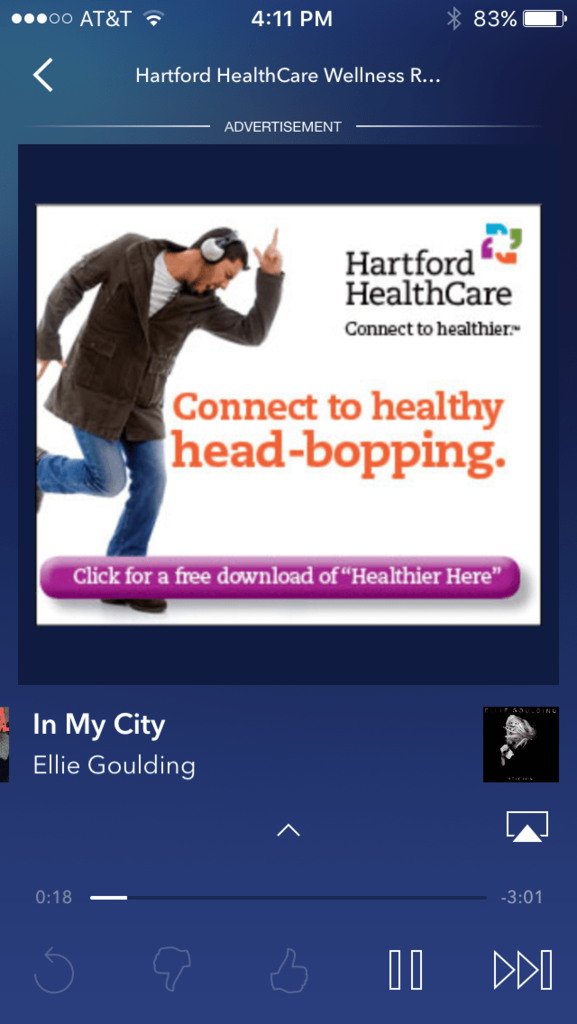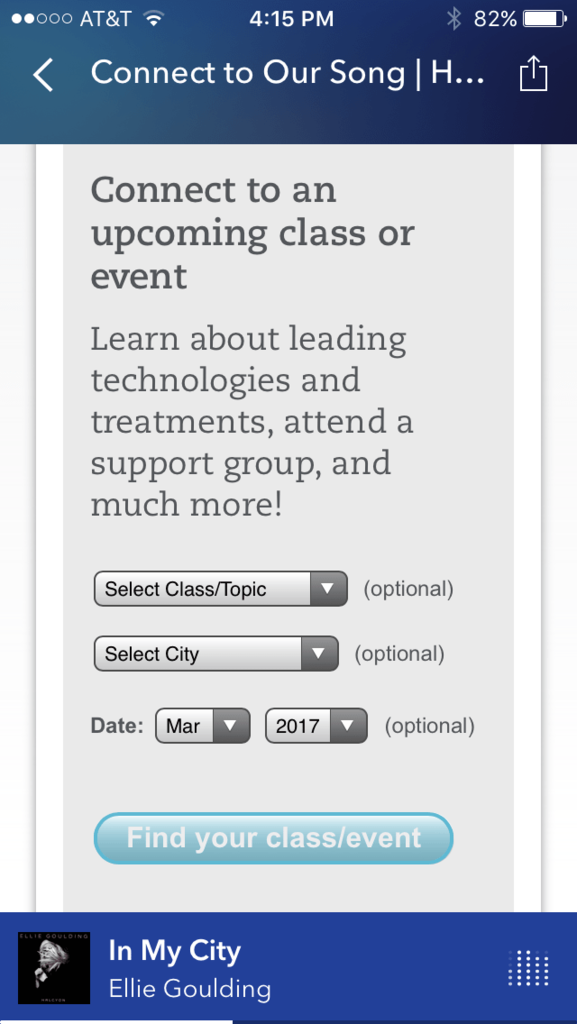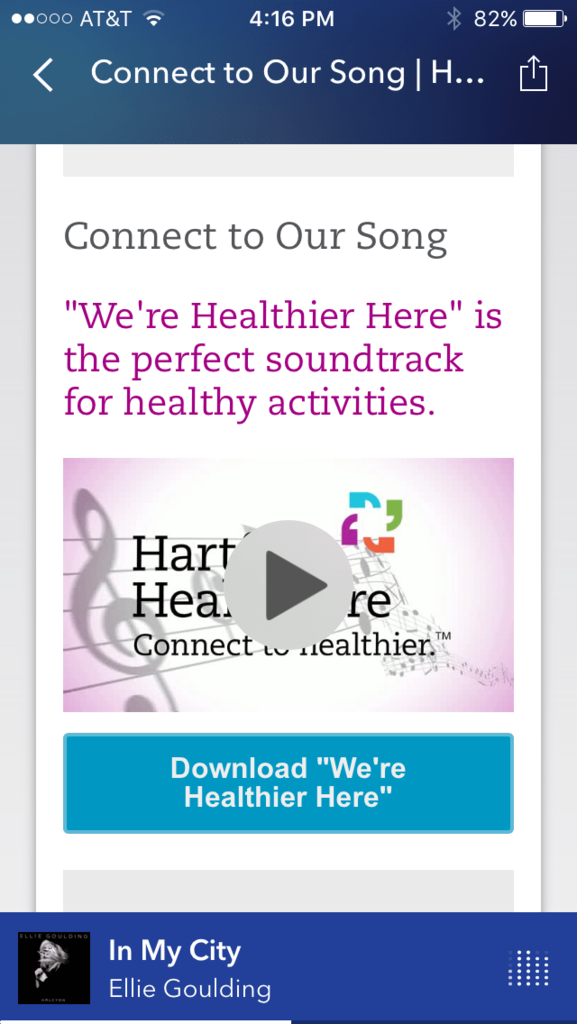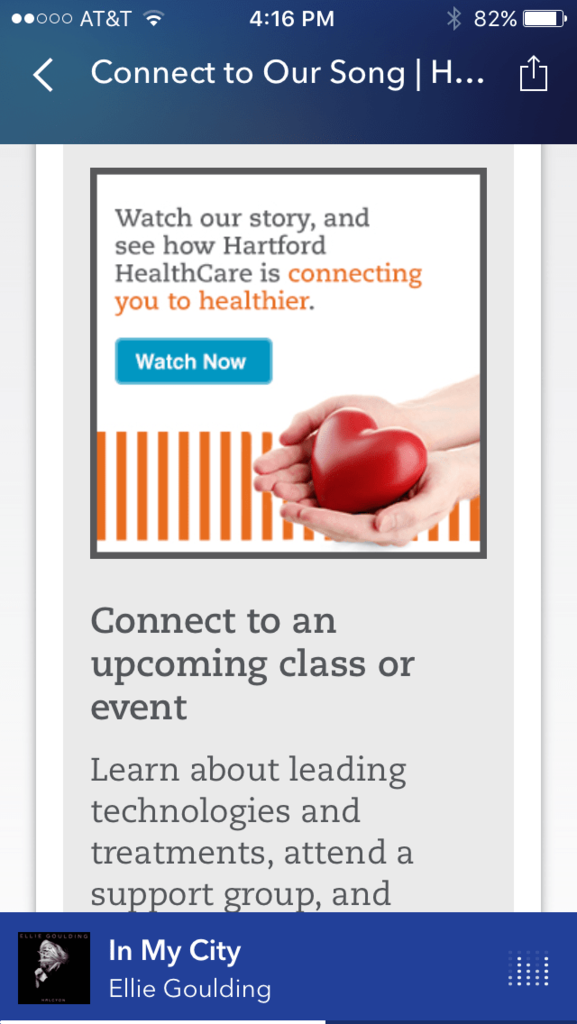7 Ways Pandora Drives Results for Healthcare Advertisers
// By Jane Weber Brubaker //
 About one-fourth of the U.S. population listens to Pandora. That’s 82 million active listeners every month. Pandora’s free, ad-supported personalized music streaming service generated more than $1 billion in advertising revenue in 2016.
About one-fourth of the U.S. population listens to Pandora. That’s 82 million active listeners every month. Pandora’s free, ad-supported personalized music streaming service generated more than $1 billion in advertising revenue in 2016.
Healthcare advertisers like OhioHealth, featured in a recent eHST article, are getting impressive results on Pandora. We were intrigued. We wanted to find out more about how Pandora advertising works—and why it works. Hint: It’s not just music. “We are not only a music streaming company; we are a huge data company,” says Lee Ann Longinotti, director of Pandora’s healthcare vertical.
 Connecticut agency Mintz + Hoke Media Only manages advertising on Pandora for Hartford HealthCare, an integrated delivery system that includes five hospitals and a multispecialty physician group, and provides behavioral health, rehabilitation, home health, and senior care services.
Connecticut agency Mintz + Hoke Media Only manages advertising on Pandora for Hartford HealthCare, an integrated delivery system that includes five hospitals and a multispecialty physician group, and provides behavioral health, rehabilitation, home health, and senior care services.
Hartford HealthCare’s ad spend on Pandora has grown steadily over the past three years, and it is now a standard part of the media mix. Commenting on why Pandora has worked so well for the health system, Sara-Beth Donovan, senior vice president of media at Mintz + Hoke says, “Pandora respects the listener experience.”
Here, we’ll see how Hartford HealthCare is leveraging Pandora to drive branding and awareness as well as conversions. We’ll take a look at how advertising on Pandora has evolved, and explore what makes it unique from an advertising perspective.
1. The Power of Personalization
Pandora was developed by musicians, and is “powered by” the Music Genome Project, the human engine of its personalization capabilities. Trained musicologists analyze every track, and have identified 450 separate musical attributes that enable the platform to select and serve up content matched to individual tastes. Listeners further refine the experience when they interact with Pandora.
Within this self-selected, Pandora-enhanced environment, ads play approximately every 10 minutes. “Our commercial content load is so low that it’s really heard and responded to,” says Longinotti. “You’re speaking with someone within a personal mix of music that is individually chosen and curated by Pandora just for them.”
Pandora recently conducted neuroscience research to measure the emotional response to a variety of different advertising channels. Pandora ads were 49 percent more memorable than the average overall ads on traditional radio, 36 percent more memorable than television ads, and 29 percent more memorable than mobile video advertising.
2. Guaranteed Engagement
Pandora learns more about listeners’ tastes each time they engage, and tailors the experience accordingly. Listeners indicate their music preferences by choosing a station or tapping the thumbs-up or thumbs-down icon while a track is playing. This interaction allows Pandora to capture the listener’s attention. “When the listener stops the music experience and changes a musical choice or hits pause, for example, we know their eyes are on whatever screen or device they’re using, and that’s when our static display ads serve,” says Longinotti. “That’s guaranteed engagement.”

Sara-Beth Donovan, senior vice president of media at Mintz + Hoke
Donovan adds, “When consumers watch TV they can time-shift and never see the commercials. On Pandora, the price of admission is to listen to an ad.”
Pandora serves static ads with or without accompanying audio, as well as video ads. “Video ads do extremely well,” says Longinotti. “The story is really important on Pandora. If you tell a story by someone that the listener can relate to as a peer, that’s the most successful creative on Pandora.” [See sidebar.]
3. Reach and Scale
Pandora’s targeting capabilities enable advertisers to zero in on desired audiences by age, gender, listening habits, and ZIP Code, and its reach gives them scale. “That’s very appealing to healthcare marketers because they are able to still deliver easily, when you carve that down to a DMA, MSA, or ZIP Code level,” Longinotti says. “With a traditional television or radio station that is serving a huge geography, you don’t have the ability to carve that down to who you want to reach. We can serve ads specifically targeted to a client’s geographical concern with no waste.”
4. Condition-Specific Targeting
For some campaigns, Pandora overlays HIPAA-compliant healthcare data from Crossix. “This allows us to deliver an impression to someone most likely to have a specific health condition,” says Longinotti. “If a health system is looking specifically to drive orthopedic appointments for someone who is into sports and fitness, 50 years old, and is likely to have had some kind of knee issues, then that’s someone that we are able to specifically talk to.”
Recently, Hartford HealthCare opened its new Bone & Joint Institute at Hartford Hospital, and is promoting it on Pandora. The target audience ranges from active younger people interested in preventing and treating injuries to older people who may need joint replacements.
5. Branded Experience on Pandora
Hartford HealthCare has its own branded station on Pandora, Hartford HealthCare Wellness Radio. The station was launched two years ago, and advertising is exclusive to the health system. Listeners can listen to and download the station’s branded song, Healthier Here, watch a video, and sign up for classes and events.




6. Beyond Branding: Leads
The most common lead generation campaigns in healthcare focus on appointment scheduling, education about specific conditions, and learning more about the system, or as in the case of Hartford HealthCare, about a specific facility within the system.
Pandora has a new feature, sponsored listening, and Hartford HealthCare recently incorporated it into the media mix. Listeners get a free hour of listening in exchange for engaging with a 15-second ad. “There is a strong call to action 14 seconds into the ad, and if listeners engage, there is more content,” says Donovan. “When you give to get, the advertiser and listener both win.”
“Some of our other KPIs that perform well are assessment campaigns, like signing up to get a cardio assessment,” says Longinotti. “Anything that [healthcare advertisers] want to drive, we’re able to do.”
Simplicity is key. “We don’t really recommend in this vertical something that requires a consumer to spend a lot of time filling out a form,” Longinotti says. “It needs to be very easy for the consumer to follow through with whatever you want them to do.”
7. Multigenerational Advertising
Pandora reaches 25 percent of the U.S. population, but some age groups have higher representation. “I would say our sweet spot is definitely 18 to 54,” says Longinotti. But the 55 to 64 and 65+ age groups are the fastest-growing demographics, as more people in this demographic acquire smartphones.
Healthcare organizations have a growing interest in targeting millennials, now in their 20s and 30s. “One in four 20- to 24-year-olds has a child in the household,” says Longinotti. “Healthcare organizations understand that it’s important to start speaking to millennials now, because they care about maternity, pediatrics, family care, and wellness.”
Another attractive demographic is adult children of aging parents who make healthcare decisions on behalf of family members. “There’s real interest in beginning to market to that healthcare influencer for specialty lines of care like cancer care, cardiology, neurology, and orthopedics,” says Longinotti.
Competitive Environment, Trends
Pandora is the largest and most established music streaming company. It has had a free, ad-supported model from day one. But there is greater competition than ever for listeners.
Spotify also has a free, ad-supported tier. As of March 2017, it had 57 million U.S. subscribers, 17 million of which are paid subscribers (no ads) and 40 million who are in the ad-supported model vs. Pandora’s 82 million. Apple Music is subscription-only and does not have an ad-supported tier, but the extensiveness of its music library could entice users to switch.
Pandora’s model is heavily advertising based, with only 5 percent of its members paid subscribers. At this point, Pandora still has significantly greater opportunities for advertisers.
How Well Does Pandora Know Me?
 I spent an hour listening to Pandora and logged the ads I saw or heard. It’s clear that Pandora knows a few things about me, and the ads I saw prove it.
I spent an hour listening to Pandora and logged the ads I saw or heard. It’s clear that Pandora knows a few things about me, and the ads I saw prove it.
Here are some examples:
- I’m a big fan of the UConn Lady Huskies, and Geno Auriemma is the coach. He is the voiceover on a spot promoting the state health insurance exchange. I’m a solopreneur and might need health insurance.
- Two Men and a Truck thinks I might be interested in franchise opportunities.
- I take a lot of pictures with my iPhone and Walgreens wants me to come in and print them.
- Several ads reflected my interest in or connection with healthcare:
- Influence Health CRM
- Hartford HealthCare sponsored listening
- Smith & Jones healthcare marketing agency
- Massage therapy training program
- I also saw ads related to my interest in business technology solutions:
- WordPress
- Coding
- Online meetings
From a consumer perspective, the ads are highly relevant. From an advertising perspective, the ads reached the right target audience—a win-win for both sides.
—JWB
Jane Weber Brubaker is editor of eHealthcare Strategy & Trends.
We gratefully acknowledge our friends at ndp for sharing their excitement about Pandora and inspiring this article. Visit them and Pandora at the Healthcare Marketing and Physician Strategies Summit, May 8-10 in Austin, Texas.

